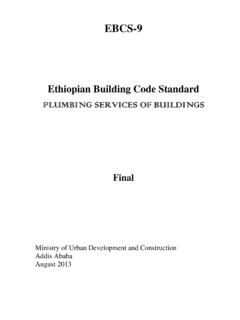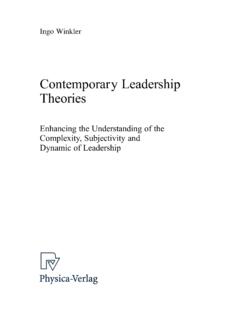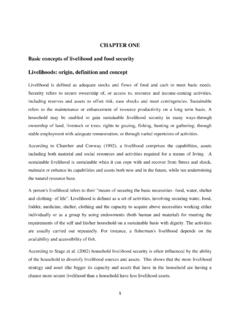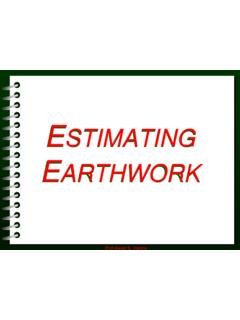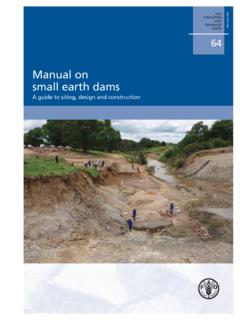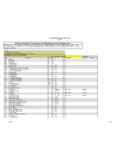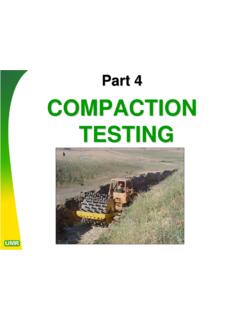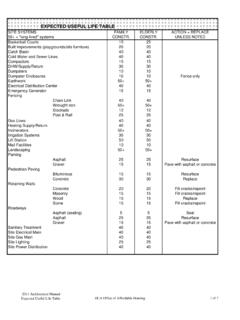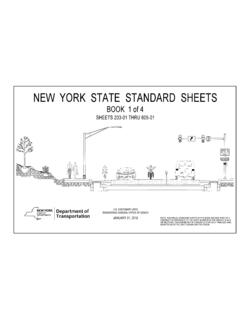Transcription of Chapter 2 Productivity of Construction Equipments ...
1 Chapter 2 Page 1 Chapter 2 Productivity of Construction Equipments : earthwork Equipments Definition: - Productivity in Construction is defined as a unit output per hour. An accurate prediction of the Productivity of Construction equipment is critical for Construction management. 1. Construction Equipment Productivity Determination Estimating actual Productivity is an essential element in estimating the time and cost required to complete Construction operations. Terminologies Peak Productivity (Qp): is the ideal or theoretical Productivity governed by design limitations only.
2 ` Where: Qp = Peak Productivity V = Volume carried/ bucket capacity fs = Bank Volume/loose volume ff = Bucket fill factor Actual Productivity : Productivity of equipment after taking care of effective working hours and job management factor on the peak Productivity . Where: Qa = Actual Productivity Qp = Peak Productivity fw = Factor to take care of effective working hours fj= Factors to take care of the management conditions The computation of the actual production of Construction equipment is complex.
3 But through idealization, approximation and in general simplification, one can arrive at an optimum result. f xf xQfspV jwpf xf xQaQ Chapter 2 Page 2 of Construction equipment Equipment can be broadly classified into two based on their Productivity concepts: these are: - cyclic operating and continuously operating Equipments . Cyclic operating equipment: These are machines which are intentionally or unintentionally influenced by their operators. The actual Productivity can be computed from: Where: Qa = Actual Productivity (Bm3/hr) Vn = Volume per cycle (Bm3) = Efficiency of the equipment no = number of cycle /Unit Time (usually Time in hours), if To is theoretical cycle time Continuously operating equipment: These are machines that continuously operate, like pumps, conveyor belts, etc.
4 For these kinds of machines the actual Productivity can be estimated from the following formula. Where: Qa = Actual Productivity (Bm3/hr) Vn = Volume per bucket a = Number of buckets = Efficiency of the equipment no = number of cycle /Unit Time (usually Time in hours) In this course only cyclic Construction equipment Productivity estimation is considered. oT 60no x 60 xon x a xnVaQ xon xnVQa Chapter 2 Page 3 2. Productivity Of Shovel Family And Excavators Qa- Shovel family is dependent on the actual volume per cycle and the cycle time.
5 Vn Volume per bucket. Plate line capacityis the bucket volume contained within the bucket when following the outline of the bucket sides. Struck capacityis the bucket capacity when the load is struck off flush with the bucket sides or volume actually enclosed by the bucket with no allowance for the bucket teeth. Water line capacityassumes a level of material flush with the lowest edge of the bucket ( , the material level corresponds to the water level that would result if the bucket were filled with water).
6 Heaped volumeis the maximum volume that can be placed in the bucket withoutspillage based on a specified angle of repose for the material in the bucket. The angle of repose depends on the type of material. Figure Struck and Heaped Bucket Capacity (Caterpillar Inc.) Commonly - Bucket ratings for the cable shovel, dragline, and cable backhoe are based onstruckvolume. Thus it is often assumed that the heaping of the buckets will compensate for the swell of the soil. That is, a 5 m3 bucket would be assumed to actually hold 5 Bank m3 of material.
7 Chapter 2 Page 4 A better estimate of the volume of material in one bucket load will be obtained if the nominal bucket volume is multiplied by a bucket fill factor(f)or bucket efficiency factor( ). If desired, the bucket load may be converted to bank volume by multiplying its loose volume by the soil s load factor. Example A front shovel is excavating a common earth. Estimate the practical capacity of the bucket inbank measure if the load factor of the material is Solution From table 2 the bucket fill factor = taking the lower value.
8 Bucket load = Bucket Volume x x fL = x x = bcy Chapter 2 Page 5 Cycle Time (Tc) In calculating the time required for a Construction equipment to make one complete cycle, it is customary to break the cycle down into fixed and variable components. Tc = Tf + Tv Where:- TV=Variable Cycle Time - Variable time represents those components of cycle time related with travel time. Itis the time required to excavate and travel to load and travel to return to its original position after loading.
9 TF = Fixed Cycle Time - Fixed time represents those components of cycle time other than travel time. It represents the time required to maneuver, change gears, start loading, and dump. Number of cycle (no) =Unit Time/Tc = 60/Tc , Where Tc cycle Time in minutes Productivity of Face Shovel (Power Shovel) A face shovels are used predominantly for hard digging above track level and for loading hauling units. Shovels are capable of developing high breakout force with their buckets, but the material being excavated should be such that it will stand a vertical bank.
10 The size of a shovel is indicated by the size of its bucket expressed in cubic meter. Estimation of shovel production. The production capacity or output of a shovel is expressed in cubic meter per hour. There are four elements in the production cycle of a shovel:-Loading bucket, swing with load, dump load and return swing with empty bucket. Chapter 2 Page 6 The output varies for various type of materials to be digged. The following are the main factors which affect the output of face shovel:- Site Condition Height or Depth of cut Type of material Angle of swing Capacity of hauling unit and continuity of work Mechanical condition of shovel Efficiency of the operator Relative positions of the shovel and hauling unit Type of machine such as crawler or wheeled A.


